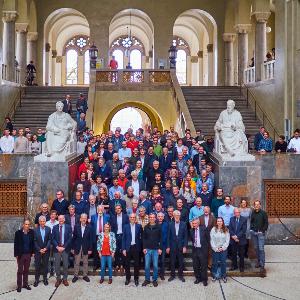Meteorological Institute at LMU celebrates 100 years
30 Mar 2023
LMU began to pursue the science of weather observation in 1923. And since the 1960s, climate change has been an important topic at the Meteorological Institute.
30 Mar 2023
LMU began to pursue the science of weather observation in 1923. And since the 1960s, climate change has been an important topic at the Meteorological Institute.

As early as 1960, the increased greenhouse effect in the atmosphere was discussed at LMU's Meteorological Institute | © IMAGO / Manngold
“If Candlemas Day brings cloud and rain, winter won’t come again”: weather forecasts have been important to people since time immemorial – especially for farmers. By the standards of the day, there was a lot of knowledge in these folk predictions. “Weather proverbs were taken very seriously at the time as frameworks for observing and forecasting the weather,” says the Chair of Experimental Meteorology at LMU, Professor Bernhard Mayer. That being said, the strike rate of the proverbs was no more than 60 to 70 percent.
To improve the accuracy of forecasts, LMU’s Meteorological Institute was founded 100 years ago, where Mayer works today with his professor colleagues George Craig, Markus Rapp, Thomas Birner, and Mark Wenig. The 1920s were a time in which meteorology was changing from an observational science to one based on quantitative measurement. Bit by bit, researchers established that the weather could be calculated if enough information was available. Without computers, however, this was a formidable challenge.
Around 30 years ago, the subjects of radiation and climate grew in importance alongside weather research, and LMU was a global pioneer in this field. As early as 1960, Professor Fritz Möller discussed in his lectures the increased greenhouse effect in the atmosphere due to rising concentrations of carbon dioxide in the air.
Together with his colleague Syukuro Manabe from the US Weather Bureau, Fritz Möller developed one of the first radiative-convective models, which paved the way for Manabe’s Nobel Prize in Physics in 2021. These models allowed scientists for the first time to quantitatively predict potential global warming. “But it was not until the end of the 1980s that climate change was really taken seriously,” says Mayer.
0:55 | 30 Mar 2023

© LMU
Thanks to the research at the Meteorological Institute in close cooperation with the German Weather Service (Hans Ertel Center for Weather Research), weather forecasting is becoming increasingly more precise. “Through new observation methods and models, forecasting is improving on average by one day every ten years,” emphasizes Mayer. The five-day forecast is now just as good as the next-day forecast from 1980. The outer limit of predictability is currently ten days.
So that we understand even better in future how clouds form, dissolve, and react to human-made particles such as particulate matter and even smaller aerosols, there is a measuring station on the roof of the institute building. With funding from the German Federal Ministry of Education and Research as part of the European initiative for aerosols, clouds, and trace gases ACTRIS, the facility is being expanded into one of the largest observation stations for clouds and aerosols in Europe. Furthermore, the Meteorological Institute in Munich plays a very active part in international aircraft measurement campaigns – and not just with colleagues at the German Aerospace Center in Oberpfaffenhofen, but also in the tropics of Barbados, for example, and at the North Pole. Through targeted measurements of clouds, particles, and radiation, the goal is to elucidate the role of clouds in the future development of climate.
To give meteorology students the skills to carry out such research themselves after their studies, they learn how to take measurements from an aircraft during an internship in Coburg – one of the highlights of the bachelor’s degree course. Master’s students, meanwhile, can take part in aerial measurement campaigns abroad, which presents a great opportunity to make new professional contacts. And the same goes for the regular get-togethers organized by the student council, which the professors also attend.
Prospective meteorologists do not lack for career perspectives. Although around half of graduates pursue careers in weather and climate research at institutes like weather bureaus and environmental bodies, private companies operating in fields such as renewable energy and insurance are very interested in their expertise. As meteorology is incorporated within the Faculty of Physics at LMU, jobs in data processing, software development, and school teaching also beckon for graduates.

Academic afternoon and celebration of the anniversary of the institute
“With a meteorology degree, you can’t go wrong,” says Mayer, adding that people who study the subject today will surely be able to spend their whole working lives on further improving weather forecasts. And in times of climate crisis in particular, people can do a lot of good in this field.
And if that was not enough, the meteorologist adds with a chuckle, there is another burning question “which 100 years of research has not been able to scientifically resolve: Do föhn winds, which Munich residents often complain about, actually cause headaches – or is it all in their imagination?”
Faculty of Physics: Meteorology